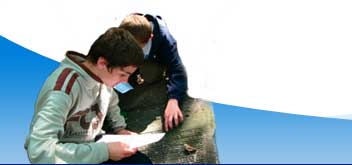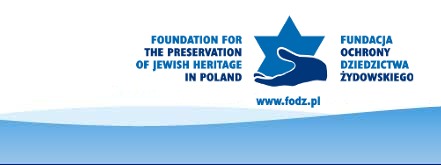"To Bring Memory Back" edition 2006-2007

NAREWKA - Zespół Szkół

Who are we
School Complex in Narewka.
The participants of the project are students from 6th grade elementary school and 2nd-3rd graders from Junior High, especially those who act in Touring School Circle run by Alina Leszczuk and in European Club run by Alina Rosinska, Jerzy Oniskiewicz and Jarosław Romanczuk. Many of us also attend the Common Room in Community’s Culture Centre in Narewka, run by Katarzyna Bielawska. We’re interested in many things, i.a.: history of our region which we learn by clearing war cemeteries, finding forgotten graves, meetings on tourist trails – bicycle rallies. Our achievements are: participation in successive editions of the contest „Narewka’s Land in Eyes of Generations”, organized by Committee of Friends to Narewka’s Land (Stowarzyszenie Przyjaciół Ziemi Narewkowskiej) – we’ve won second prize for an album “On Traces of the Past”. More information about us and our town can be found at www.narewka.pl and http://zespolszkolnarewka.republika.pl/
Why we do this project
There is a place on earth where you’ll hear different speech and singing. Nearby temples are devoted to different religions: Orthodox, Roman Catholic, Protestant and Jewish in the past. This place is Narewka. When our grandfathers start telling abort pre-war limes, in one moment there is a buzz of voices… In streets of Narewka there were many shops, stalls, inns, apothecaries, a Christian girl lights a fire for Hana, because it is time of Shabbat; it is raining because it is kuczki… People pass away and with them something what simply cannot be read in a book, something very subtle: tolerance, respect, living not side by side people but for the people. This is why we’ve decided to participate in “To Bring Memory Back” project. We want to save the memories by reviving them while doing the project in the same time show to ourselves and to the world that many cultures enrich both the land and the people.
Jewish community in our town
To the mosaic of many cultures of Bialowieza Region we have to enlist a Jewish one which on area of our particular interest in less than one and a half century coexisted with the Christians. Good conditions for Jewish residents settling in Podlasie were mainly: location of new towns, peace prevailing to the half of 17th century and positive attitude of property- and town owners. Relationships between religions were also not without meaning. The Jewish population (in the end of 18th century) contributed to economical development of many towns and villages, changing them into merchants’ and craftsmen’s centers. At times of World War II the Jews were exterminated.
After mosaism believers there remained only the material and spiritual culture. The latter is registered only a little because its carriers are residents of Bialowieza region who remember their Jewish
neighbours to this day – but alas their number is smaller with every passing year. Jewish community settled in Narewka in the turn of 18th/19th century. In year of 1880 for 863 town’s residents as much as 778 (90 %) were of Jewish origin. After the third partition of Poland – there were 10004 Jewish residents (79 %). Close on the war Narewka had 1000 residents and 50% of them were Jews. In World War II on August 15th 1941 Jewish community of Narewka was cruelly murdered. Men and boys over 16 were slaughtered near Zablotczyzna village, women and children were directed to Prużany and Kobryń (Belarus). The only remain after Jewish culture is a cemetery where Jews from Szereszewo, Swisłocz (Belarus), Bialowieza and Hajnowka are buried. There are about 250 matzevot on the cemetery – 50 of them were not registered (they were buried in the ground, overgrown with grass, not lifted up). Most of them are typical Ashkenazi tombstones: simple, crowned with semi-circular epitaph tablet. They are made from pudding stone, granite, concrete, sandstone.
One tombstone
was made
from labradorite
. Majority is in good shape, their lettering readable and well preserved. On dozen or so inscriptions there original colours are well preserved too: black, yellow, red, silver and even violet. Symbolic representation is modest, most often one can see a likeness of Star of David. Among other ornaments there are contours and floral motives, drawings of hands, broken trees and candles.One of the remains is also an old street pattern dated as being from 18th century. The spatial pattern of the town is changed too: for example today’s Ogrodowa St. was formerly Szkolna St. – synagogue was located there along with religion school (Szkolna St. – School St. in English); today’s Nadrzeczna St. was formerly Garbarska St. The names, i.a. of course, originated from professions of resident Jews. Some of wooden houses can also be remembrances– but their architectural character is often disturbed.
What we do in the project
1. School Jewish Film Festival;
2. Trip to Tykocin;
3. Gather relations about Jewish connumity living in Narewka before the World War Two;
4. Clean up the Jewish cemetery;
5. Organize children's art contest and the following exposition;
6. Create a photo album presenting the effects of our work;
What we are going to do next
To this day we participated in contest of making an advertising leaflet promoting multicultural heritage of our town. Our activities were mainly the broadening of our knowledge about Jewish culture. Aiming
to that
we went to Tykocin. In Białystok a guide waited for us and told us about history of the town and Jewish settlings in it, then guided us in Tykocin: we visited Catholic church, seminary, synagogue and museum, Jewish cemetery and reconstruction of the castle. In the synagogue we’ve met with another guide who told us about the origins of Jews from podlaskie province, how places and objects in the temple are called, what are Jewish festivities and many more… On the way back we saw the Jewish cemetery in Białystok which made an impression on us due to the variety of symbols on matzevot. Further stages of the project are: meetings preparing to particular activities, meeting with director of the film „Holiday Azimuth 2000” together with its projection, showing of the film „I dreamed about Hana”, interviewing people remembering Jews, culinary meeting – “We’re Making Jewish Meal”, publishing news about the project in local newspapers, placing an advert there to residents of the town to make their Jewish keepsakes accessible for us (like stories, newspapers, photos and other things). Sponsoring the cemetery – making its documentation, putting an information tablet and sign post near the cemetery , elaborating permanent exhibition commemorating Jews from Narewka in Tamara Sołoniewicz gallery, presenting our activities in School complex and Community’s Culture Centre in Narewka.
Who is helping us
Community’s Culture Centre in Narewka – Katarzyna Bielawska, Commune Office in Narewka and the village-mayor - Mikołaj Pawilcz, WWF- Stefan Jakimiuk, editor-in-chief of “Nad Narewką” gazette – Jadwiga Karpiuk, residents of Narewka, 37th Border Guard Scouting Troop, and Committee for Preserving the Landscape in Hajnówka – Janusz Korbel.
What are we proud of
We are proud of multicultural background of Narewka. People of various religions and nationalities have lived here from ages. Have lived and still are living in peace.
Today the descendants of Narewka’s Jews come here – as these who were gone before 1939. The sound of Hebrew names and surnames is still moving.
On the cemetery and the mass grave from few years there are little stones on the matzevot. The memory is alive again.
In 1999 the film „I dreamed about Hana” directed by Mikołaj Wawrzeniuk from TV Bialystok won a second prize on the Festival of Documental and Ethnic Films in Krakow. The movie is about pre-war life of Jews and Christians from Narewka and vicinity.
We are proud the local newspaper „Nad Narewką” published materials about us and the project.
http:\\republika.pl\zespolszkolnarewka\
www.powiat.hajnowka.pl
Radio Białystok broadcasting some of the programs also in Belarussian language also is interested in our activities.
They recorded us in Polish and Belarussian on February 4th 2007.
Paulina Rubczewska was awarded in nationwide contest for a leaflet promoting multicultural background of the town.





